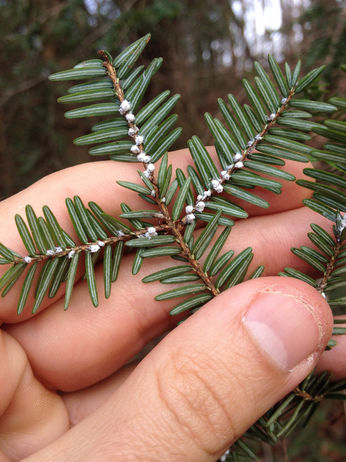
Eastern Hemlock Project
Eastern Hemlock (Tsuga canadensis) is a very long-lived tree species (up to 800 yrs. old) that is common in old-growth forests south of the Boreal Forest in eastern North America. Because it doesn’t recover well after disturbance, eastern hemlock is often found in areas that have never been logged. Although it has declined significantly in southern Ontario, eastern hemlock is still a relatively common tree species in parts of central Ontario. However, between 1987 and 2007 eastern hemlock-dominated forests (>50% hemlock) declined by 16% in Ontario and may disappear by ~2075 – only about 50 years from now.
In Algonquin Park there are more than 20,000 hectares of eastern hemlock-dominated forest over 180 years old, and eastern hemlock trees over 400 years old have been found throughout Ontario including the Niagara Gorge, Burnham Woods near Peterborough, and several places in the Algonquin, Kawartha, and Muskoka regions. Older hemlock trees are often overlooked because they can grow very slowly beneath a canopy or on a poor site resulting in a deceptively small size.
Shorelines and river valleys are geomorphological locations where eastern hemlock is typically found in high densities and volumes, particularly on the north slopes of ravines. As an ecosystem foundation species, it strongly influences habitat conditions where it grows. For example, the dense shade of eastern hemlock groves reduces the temperature of streams throughout the summer. Streams that run through eastern hemlock valleys average about one to two degrees Celsius cooler than in nearby hardwood forests creating important habitat for coldwater fish species such as brook trout. This tree species also helps maintain summer water levels in streams by storing spring snowpack longer and by reducing summer evaporation of water from the soil.
In addition to the adverse affects of continuing logging, eastern hemlock forests are being severely damaged by a sap-sucking insect that kills trees called hemlock woolly adelgid. This non-native alien species has devastated forests containing eastern hemlock throughout the eastern U.S. and Nova Scotia. Recently, the adelgid has been detected only about 120 km south of Canada’s largest known old-growth eastern hemlock forest located on Catchacoma Lake, Trent Lakes Municipality, Ontario. The pest is moving northward in Ontario and will soon start causing significant damage to some of the province's most valuable eastern hemlock forests. Thus, our Eastern Hemlock Project aims to document and characterize remnant eastern hemlock forests in southern and central Ontario and to encourage citizen engagement in their stewardship to minimize losses from logging and the invasive adelgid.
Publications
Research Reports
Catchacoma Forest Species Inventory 2022 Field Season (RR#45, 2023)
Carbon Storage and CO2 Produced by Logging in the Catchacoma Forest. (RR#43, 2023)
Natural Heritage Values of the Unprotected Catchacoma Forest (RR#41, 2021)
The Catchacoma Ancient Forest Landscape: An Initial Inventory of Species and Habitats (RR#39, 2020)
Conserving Southern Ontario’s Eastern Hemlock Forests: Opportunities to Save a Foundation Tree Species. Appendix 1a. Hemlock Handout. Appendix 1b. HWA Detection Handout. Appendix 2. Site Descriptions of High Conservation Value Eastern Hemlock Forests (RR#38, 2019)
Forest Landscape Baseline Reports
Minimum Standards (live- and dead-wood) for Verification and Delineation of Old-growth Eastern Hemlock Forests (FLB#41, 2025)
An Inventory of Documented Old-growth Eastern Hemlock Forests in Canada. (FLB#35, 2019)
Field Notes Reports
Rapid Assessment of Large Trees in an Unprotected Endangered Eastern Hemlock Old-Growth Forest at the Northeast End of Manitou Lake, Algonquin Park,Ontario. (FNP#03, 2020)
Preliminary Results Bulletins
Mother Tree Survey in the Central Portion of the Catchacoma Forest, Update (PRB#13, 2022)
2022 Field Season Results Update, Catchacoma Forest, Trent Lakes, Ontario (PRB#12, 2022)
Rapid Old-growth Survey in the Heart of the Catchacoma Forest by YLS Students (PRB#11, 2021)
Comparing Stand Ages Using Tree Cores and Forest Resource Inventory Mapping from 1987 and 2007 in the Catchacoma Forest (RR#10, 2021)
Rapid Assessment of Old-growth Characteristics in the Catchacoma Forest (PRB#09, 2020)
Rapid Surveys to Assess Old-Growth Eastern Hemlock Forests in the Greater Toronto Area (PRB#07, 2019)
The Cayuga Lake Old-Growth Forest Landscape: an Unprotected Endangered Ecosystem in Algonquin Provincial Park, Ontario. (PRB#06, 2018)
A rapid survey of Oakview Woods: an Old-growth Forest in Wasaga Beach Provincial Park, Ontario. (PRB#05, 2018)
The Old-Growth Forests of Bronte Creek Provincial Park: an Urban Old-Growth Forest Threatened by Invasive Species (PRB#04, 2018)
The Hurdman Creek Old-Growth Forest: an Unprotected Endangered Old-Growth Forest in Algonquin Provincial Park, Ontario (PRB#02, 2018)
Guidebooks, Handouts, other Educational
Eastern Hemlock: an Ecologically Important Species & Hemlock Woolly Adelgid Biology (Handout, 2017)
A Citizen’s Guide to Hemlock Woolly Adelgid Detection in Ontario. (Handout, 2017)









